
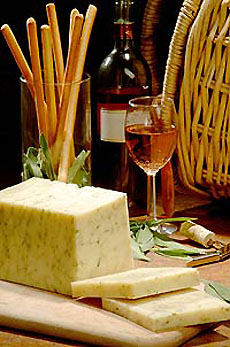
The right wine and the right cheese make a great gastronomic marriage. Photo of Fiscalini Cheddar with wine. Read our full review of Fiscalini Farmstead cheeses.
|
Wine columnist R. VERONIQUE FITZGERALD is a wine consultant and writer based in New York City.
|
|
October 2007 |
 |
Product Reviews / Main Nibbles / Wine
Cheese & Wine Party Ideas & Cheese Pairings
Pairings & Tips For A Party
CAPSULE REPORT: Whether you want to throw a formal wine and cheese party, have a few friends over for a wine and cheese tasting or want to know more about the art of pairing wine with cheese, here are suggestions from a recent successful party menu. Try these combinations at your next party—or simply a few at a time on the cheese tray after dinner. The pairing recommendations push the envelope a bit: they’re not the standard wines or the standard cheeses. So if you’re putting together a gift basket or house gift for someone who loves wine and cheese, they’re great gift suggestions as well.
Introduction
Wine is not the only food category that comes with descriptive language. As such, my first compulsion when putting together a wine and cheese tasting was to identify similarities and contrasts in the descriptions of the cheeses and wines I was to taste. We tried red and white wines from all over the world, dry and sweet, armed with some insights gleaned from THE NIBBLE’s article on Cheese Terminology. We also visited a new cheese boutique in Brooklyn, New York for some cheese expertise—the enticingly-named Stinky Cheese. The signs identifying the cheeses in the displays at Stinky list wine recommendations that could be purchased from Smith and Vine, a wine shop on the next block (Smith Street) owned by the same proprietors. Gina, one of the consultants at Stinky, helped us with some recommendations.
We invited some members of the New York City Chapter of Women for WineSense over for a wine and cheese session, using suggestions from The Nibble’s article on A Cheese Tasting Party. We also made fondue, tasting the full line of Damn Good Jerky for dipping.
Wine & Cheese Pairings: The Line-Up
Here are some of the great matches we discovered. Whether you want just one great wine and cheese for your cheese course, or want to entertain with an entire tasting as we did, we recommend these as a delicious departure from “the usual” (whatever your own personal “usual” might be). Your cheesemonger can help you with substitute cheeses; for example, if the shop does not carry Crave Brothers Petit Frère, other washed rind cheeses will fit the bill.
White Wines
- Château Mont-Redon Châteauneuf-
du-Pape Blanc (France)
- Don Olegario Albariño 2006 (Spain)
- Innocent Bystander Pinot Gris 2006
(Australia)
- Sequoia Grove Chardonnay 2004 (USA)
- Shoofly Buzz Cut White Blend 2006
(Australia)
Sweet White Wine
- D’Arenberg The Noble Riesling 2001
Red Wines
- John Duval Plexus GSM 2005
(Australia)
- Nozzole Chianti Classico Riserva 2004
(Italy)
- Papantonis Agiorgitiko Meden Agan
2004 (Greece)
- Penley Estate Hyland Shiraz 2005
(Australia)
|
The Cheeses
- Cato Corner’s Hooligan (USA)
- Crave Brothers Petit Frère
(USA)
- Manchego (Spain—see photo
below)
- Pecorino Grand Old Man
(Italy—see photo below)
- Red Spruce 7 Year Cheddar
(USA)
- Roaring 40’s Blue (Australia)
- Sprout Creek’s Toussaint
(USA—see photo below)
- St. Marcelin (France)
- Queso Clara (Spain)
|
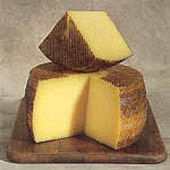 |
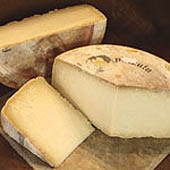 |
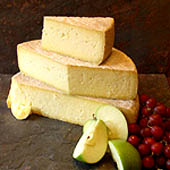 |
| Manchego. Manchego is Spain’s most famous cheese, produced in the La Mancha region from 100% sheep's milk. It is recognized by the zigzag pattern etched into its rind by the surface of the press. The cheese above was aged for more than 12 months, giving it a sharper, nuttier flavor and a firmer, more brittle texture than younger Manchegos. |
Pecorino “Grand Old Man.” For more than 50 years, the Putzulu family has been making pecorinos in the small Renaissance town of Pienza, south of Sienna, an area of Tuscany famous for its pecorinos. Their “Grand Old Man” is based on their grandfather's recipe, and aged for over 15 months. |
Sprout Creek Farm “Toussaint.” Made in Dutchess County, New York from grass-fed Jersey, Guernsey, Milking Shorthorn and Brown Swiss cows (the herd is hormone-free and antibiotic-free), Toussaint cheese is firm and pronounced in flavor with a sharp bite and a lingering finish. It also goes nicely with Pinot Noir. |
Cheeses available from iGourmet.com.
White Wine & Cheese Pairings
We began, as always, with the white wines. If you want to find a wine in your area, look, as we do, on WineSearcher.com. You can also see the best prices.
 Don Olegario Albariño 2006 Don Olegario Albariño 2006
Rías Baixas, Spain ($22.00)
This classic crisp white from the rainy northwestern region of Galicia made good company for two softer cheeses, one from Spain and a perennial award-winner from the U.S. The herbaceousness of Queso Clara, a lightly pressed raw goat’s milk cheese also from Spain, complemented the grassiness in the albariño and revealed ripe melon fruit in the wine. The wine’s crisp acidity was a perfect foil for the spreadable creaminess of Crave Brothers Petit Frère, a washed-rind, soft-ripened cow’s milk cheese from Wisconsin (and a NIBBLE favorite). Petit Frère’s edgy, barnyardy character also provide a great showcase for the wine’s lovely fruit character. St. Marcelin, another washed-rind cheese that comes in a little stoneware crock and can be warmed in the oven or microwave, would work just as well. Most stores still stock the 2004 and 2005 vintages of the Don Olegario Albariño, though I wouldn’t bet on anything older than 2005. A couple of stores in New Jersey and California have it for under $20.00.
TIDBIT:
Adolfo Falcón began the winery in 1950; his son, Olegario Falcón took over in 1980. Albariño, a Rías Baixas D.O. (Denomination of Origin) wine, is the only wine made. The grape has small, spherical, golden seeds and yields wines of remarkable acidity, with alcoholic levels from 12.5% to 13.5%.
 Innocent Bystander Pinot Gris 2006 Innocent Bystander Pinot Gris 2006
Yarra Valley, Australia ($20.00)
There’s more to love than just the name of this screw top white from Down Under. It’s dry with lime, mineral and wet stone aromas and white pepper, honeydew and chamomile on an unctuous palate. At 14.2% alcohol, it is brawny enough to stand up to the pungency of Roaring 40’s Blue cheese, a fellow Aussie. The crisp acidity in the Pinot Gris cut through the creamy texture and the dry, herbal profile was a nice counterpoint to the cheese’s slight sweetness. It also stood up well to Pecorino Grand Old Man, a Tuscan cheese whose nutty earthiness brought out more melon fruit in the wine. Some stores still have the 2005 Pinot Gris; one store in Woburn, Massachusetts has it for a mere $16.65 a bottle! About that screw top: If you aren’t yet accustomed to screwing off and on the tops of your bottles, get with it. Many wines meant to be enjoyed in the short term are using screw tops. For one, it means you’ll never get a corked bottle of wine. (And second, you never need to have a bottle opener.) Some very fine bottles are capped with screw tops—there’s no inference of modest wine.
TIDBIT: No innocent bystanders here, just people who like to eat and drink good food. If you ever get to the winery in the Yarra Valley, you can do more than tour the winery and taste the latest vintages. There’s a café with wood-fired oven pizzas, house-made breads and European pastries, house-roasted coffee, house-matured cheeses and a selection of craft beers on tap.
 Shoofly Buzz Cut White Blend 2006 Shoofly Buzz Cut White Blend 2006
Victoria, Australia ($14.00)
This Victorian is a crowd pleaser packed with juicy tropical fruit. The nose is lovely, redolent of lychee, pineapple and vanilla cream. It is magic with the herbaceous Queso Clara, and provides a nice counterbalance for the sharp and creamy Petit Frère from Wisconsin. The best price for Shoofly Buzz Cut is $9.95 at a shop in Portland, Oregon.
TIDBIT: Yes, the company’s mascot is a fly, and there’s one screened onto every bottle. Is that because there are so many flies in the hot agricultural area and everyone is constantly shooing away the insects buzzing around their heads? “Shoofly, don't bother me…” say the vintners. To show that no little pest can get to them, they name their wine after him.
 Sequoia Grove Chardonnay 2004 Sequoia Grove Chardonnay 2004
Carneros/Napa Valley, California ($24.00)
While this wine does have the aroma of new oak and some vanilla on the palate, it also shows lovely crisp acidity and pear notes, as it was spared from malolactic fermentation, a process that results in the commonly buttery styles of California Chardonnay. It made a nice match for Sprout Creek’s Toussaint, a pressed cheese of raw cow’s milk made in Poughkeepsie, New York. Surprisingly, it was the delicious vanilla and nut notes from the oak in the Chardonnay that tasted great with the cheese’s salty earthiness. Both Stinky and Smith and Vine recommended Peconic Bay Chardonnay from the North Fork of Long Island, which is also aged in oak. Older vintages of Sequoia Grove’s Chardonnay are still around. Give one a try if it was stored well.
TIDBIT: Founded in 1980 on the site of an 1850 farmhouse, Sequoia Grove is named for a circle of giant redwood trees that surround it—one of the last sequoia groves in the Napa Valley.
Château Mont-Redon Châteauneuf-du-Pape Blanc
Rhone Valley, France
($34.00)
White Châteauneuf-du-Pape, a blend of Rhône valley white varieties, is often overshadowed by its more famous, rich, full-bodied red counterpart. This is a shame, because Châteauneuf Blanc can be very intriguing and complex (but if fewer people are scrambling for it, that leaves more of the wine for those of us in the know). The nose was redolent of ginger, lemon verbena and apricot, while the palate was primarily hay and lime laced with oak, stone fruits and walnut flavors. The many flavors in the wine brought out interesting fruity and earthy notes in Queso Clara. With the nutty, slightly caramel Manchego, more layers of flavor came out of the Châteauneuf Blanc. Look for white Châteauneuf-du-Pape from great producers like J.L. Chave, Domaine Paul Autard, J Vidal Fleury, Font de Michelle and the venerable Domaine Vieux Telegraph (the latter around $25.00 a half bottle, and worth it).
TIDBIT: Château Mont-Redon is one of the great crus of Châteauneuf-du-Pape. It is situated on the high, stony plateau overlooking the Rhône River, considered to be the finest microclimate of the region, and is one of very few estates that all three soil types found in the appellation. The Via Antiqua, the old Roman route to northern Gaul, once wound its way through what are now the vineyards of the Château.
Red Wine & Cheese Pairings
While the reds are heavier bodied, we matched the wines to some of the same cheeses we enjoyed with the whites, and brought in some new cheeses as well.
 Nozzole Chianti Classico Riserva 2004 Nozzole Chianti Classico Riserva 2004
Tuscany, Italy
($27.00)
Raspberry and bay leaf notes on the nose contrasted with earthy, mushroom flavors in this medium-bodied Tuscan red. Cheese consultant Gina’s suggestion of Pecorino Grand Old Man, also from Tuscany, was a no brainer—in classical wine regions of Italy and France, the wines of a particular region were originally created to complement that region’s food. This still holds true, as the earthy nuttiness of the cheese helped to reveal berry fruits in the wine, and the wine’s relatively high acidity carried the fruit over the backdrop of the cheese gracefully. A Port Chester, New York store offers this Chianti Classico Riserva for a mere $20.99 a bottle—see if you can do as well in your area.
TIDBIT: This historic estate is located in the Chianti Classico region, 30 kilometers south of Florence.
It dates back to 1300 and was mentioned in the Cronaca Fiorentina of Giovanni Villani, a history of Tuscany written in the early 1300s.
Papantonis Agiorgitiko Meden Agan 2004
Nemea, Greece
($25.00)
A brand new import from the young, vibrant Papantonis family in Nemea, this red is  recioto (ruh-CHO-toe) style, meaning the grapes were dried before being crushed and pressed to make the wine. The result is a richly concentrated wine of power and elegance. It is made from agiorgitiko, a venerable native Greek grape also known as St. George. The dried fruit and smoky undertones in the wine made it a nice pair with Red Spruce 7 Year Cheddar from Wisconsin’s award-winning Roth Käse. The Cheddar is a rather sharp style that is deep orange in color from age, with a striking black wax rind. recioto (ruh-CHO-toe) style, meaning the grapes were dried before being crushed and pressed to make the wine. The result is a richly concentrated wine of power and elegance. It is made from agiorgitiko, a venerable native Greek grape also known as St. George. The dried fruit and smoky undertones in the wine made it a nice pair with Red Spruce 7 Year Cheddar from Wisconsin’s award-winning Roth Käse. The Cheddar is a rather sharp style that is deep orange in color from age, with a striking black wax rind.
TIDBIT:
You can tell your guests that the name Meden Agan is actually a well-known Greek motto meaning “nothing in excess” (meden means zero or nothing, and agan translates to excessively). “Meden Agan” and “Gnothi Sauton” (“know thyself”) are the two maxims carved on the walls of the temple of Apollo, the dwelling of the Oracle of Delphi, where Greeks both great and humble came for an auger or pronouncement of wisdom. These were the fundamental principles of the ancient Greek spirit. The motto “Meden Agan” is attributed to Chilon of Sparta, one of the Seven Sages of the ancient world. His teaching was that the truth lies in the middle, without excess. In this wine, rich fruit lies in the middle, without excess.
Penley Estate Hyland Shiraz 2005
 Australia
($20.00) Australia
($20.00)
This wine shouldn’t be hard to find. It’s also not shy, at a whopping 15% alcohol. This Shiraz is a perfect match for a powerhouse cheese like Cato Corner’s Hooligan, a raw, washed rind cow’s milk cheese from Connecticut with a “three nose stink level” rating from Stinky (it’s nickname is “The Great American Stink Bomb”). The wine’s jammy fruit, chewy tannin and high alcohol stood up well to the Hooligan’s chewy, salty, rather edgy profile. The cheese actually brought bright cherry and raspberry fruit out of the wine. The Shiraz also worked with Sprout Creek Toussaint—bringing out a nuttiness in the cheese that I had not noticed before—and the Red Spruce 7 Year Cheddar. Together, the Shiraz and the Cheddar meshed to create a whole new, meaty, smoky flavor in the mouth. Like stinky cheeses? Read our article about some of the world’s most famous stinky cheese.
TIDBIT: Winemaker Kym Tolley is a wine industry blueblood. On his mother’s side, he is a direct descendant of Penfolds founder Dr. Christopher Rawson Penfold—his great-great-great-grandfather. His father’s side, the Tolleys are another of Australia’s pioneering wine families.
 John Duval Plexus GSM 2005 John Duval Plexus GSM 2005
Barossa Valley, Australia
($35.00)
For the uninitiated, GSM stands for Grenache, Shiraz, Mourvedre, a trilogy that has become a uniquely Australian signature, although it is clearly a nod to the artfully blended wines from the Southern Rhône Valley in France. Here’s another bully, with 14.5% alcohol, to stand up to the Hooligan “stink bomb.” The cheese revealed raspberry and blueberry fruit on a wine that was otherwise smoky, toasty and somewhat herbal on its own. The wine revealed an interesting nuttiness in the Red Spruce 7 Year Cheddar. While it is available nationwide, one shop in Elkin, North Carolina has it for a great price, $27.99.
TIDBIT: Before starting his own label in 2003, John Duval spent 29 years as a winemaker with Penfolds, one of Australia’s most famous wineries; he was appointed Chief Winemaker at Penfolds in 1986. While he states that “John Duval Wines will never be another Penfolds,” he is enjoying making premium wines with great Australian fruit.
Sweet Wine & Cheese Pairings
 No tasting would be complete without a marvelous dessert wine. We chose a classic wine and cheese pairing, Sauternes and blue cheese. Our Sauternes is actually an Australian semillon (the grape used for Sauternes) infected with “noble rot,” Botrytis cinerea, a fungus that attacks the grapes and causes them to rot. While most grape growers pray that rot does not come near their vineyards, those making sweet wine from Semillon or Gewürtztraminer pray for it. As the mold leaches moisture from the grapes, causing them to wither, the juice inside becomes more concentrated and creates the most viscous and glorious of wines. Blue cheese, too, is made glorious by a completely different mold (Penicillium roqueforti or other species of Penicillium, depending on the cheese). Who would have thought that combining two foods based on fungus and mold would be so glorious! No tasting would be complete without a marvelous dessert wine. We chose a classic wine and cheese pairing, Sauternes and blue cheese. Our Sauternes is actually an Australian semillon (the grape used for Sauternes) infected with “noble rot,” Botrytis cinerea, a fungus that attacks the grapes and causes them to rot. While most grape growers pray that rot does not come near their vineyards, those making sweet wine from Semillon or Gewürtztraminer pray for it. As the mold leaches moisture from the grapes, causing them to wither, the juice inside becomes more concentrated and creates the most viscous and glorious of wines. Blue cheese, too, is made glorious by a completely different mold (Penicillium roqueforti or other species of Penicillium, depending on the cheese). Who would have thought that combining two foods based on fungus and mold would be so glorious!
D’Arenberg The Noble Riesling 2001 ($25.00, 375ml)
McLaren Vale, Australia
This was a tale of two blues, and the learning experience here was that all blues are not created equal. While this amber-colored, honeyed dessert wine with lovely flavors of ripe cantaloupe, dried apricot, almond, lemon drop and vanilla bean clashed with the Roaring 40’s Blue, a creamy cow’s milk blue that also had a surprising sweetness to it, The Noble became best friends with a classic Roquefort. Opposites attract in this pair: The cheese was salty, somewhat acidic and pungent and relatively dry in texture; the wine, sweet with honeyed fruit and nutty flavors. A Beaverton, Oregon store had the best price on The Noble at $20.99.
TIDBIT: The harvest date of botrytised grapes is critical. Harvest too late and the fruit can become washed out, too early and the fruit will not have fully developed the degree of botrytis require to make good (or great!) wine.
Wine and Cheese Pairing Guidelines
Some recurring themes make for great guidelines for pairing cheese and wine:
- Dessert Wines + Roquefort = Delicious!! Nonetheless, this does not hold true for all blue cheeses. A creamier blue’s texture may create too much viscosity in the mouth to layer a sticky sweet wine on top of it, and as with the Roaring 40’s Blue, flavor profile does make a difference. Also, fortified sweet wines like Port and Banyuls will probably not work here.
- High Alcohol Jammy Wines + Pungent Cheeses = Tour de Force!! Pungent, sharp, tart washed-rind aromatics and pressed cheeses work well with big reds that are jammy and high in alcohol, including Shiraz from Barossa and Hunter Valley in Australia, Syrah from Central Coast California and the Southern Rhône and big California Zinfandel and Petite Sirah wines. Bold cheeses overpower lighter wines. Try sweet fortifieds with the sharper, more pungent pressed cheeses that have dryer textures.
- Crisp White Wines + Creamy Cheeses = Lovely! Creamy, spreadable textures in cheese are often tempered by the acidity in crisp white wines, but the cheese’s flavor intensity should be mild enough to match well.
- Partners Help Each Other. When considering flavor profiles, great pairings occur when the wine brings more flavor out of the cheese or vice versa, i.e.: an earthy cheese may reveal more fruit in an otherwise grassy, herbaceous white, as in the case of Pecorino Grand Old Man and Innocent Bystander Pinot Gris.
- Location Matches Rarely Miss. When choosing wines and cheeses from Italy and France, remember that historically, the wines of the regions in those countries were made to go with that region’s foods. Choosing traditional cheeses and wines from the same region is a safe bet to a happy pairing!
Damn Good Jerky
From Damn Good Foods in Stillwater, New York comes a line of flavorful, nicely textured beef jerky in 2-, 4- and 8-ounce packages. My husband, Chef Shehu, first came across them at a gas station on his way to snowboard at Hunter Mountain in New York 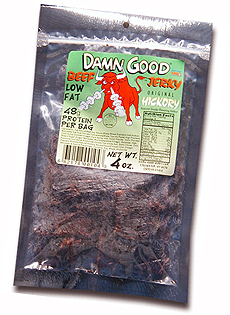 State. He didn’t actually try it until two months later, on another snowboarding trip in Davos, Switzerland. “I was hiking up this mountain face to get some freshies. When I got to the peak I needed a little snack before tackling the descent,” he related, and discovered that he still had the jerky in his pack. “Damn, this is some damn good jerky,” he exclaimed upon tasting it, “this is truly the best jerky I’ve ever had!” (Now you know where the name comes from. State. He didn’t actually try it until two months later, on another snowboarding trip in Davos, Switzerland. “I was hiking up this mountain face to get some freshies. When I got to the peak I needed a little snack before tackling the descent,” he related, and discovered that he still had the jerky in his pack. “Damn, this is some damn good jerky,” he exclaimed upon tasting it, “this is truly the best jerky I’ve ever had!” (Now you know where the name comes from.
Shehu was so impressed that he kept the package to find out where to get some more, and got a package of each of their eight flavors, which include Garlic, Hickory and Teriyaki. Our favorites were Barbecue, Black Pepper and Hot N’ Spicy. Contrary to expectations, the jerky tasted great with the two crisp, light whites (Don Olegario Albariño and Shoofly Buzz Cut) and the Châteauneuf-du-Pape Blanc, providing earthy, gamey, smoky counterbalance. The jerky is priced from $2.99 for a 2-oz package to $11.49 for an 8-ounce bag. There are also gift sets. The jerky can be purchased at their DamnGoodJerky.com. Regarding Death by Jerky, proceed at your own risk.
Lifestyle Direct, Inc. All rights reserved. Images are the copyright of their respective owners.

|








 Don Olegario Albariño 2006
Don Olegario Albariño 2006 Innocent Bystander Pinot Gris 2006
Innocent Bystander Pinot Gris 2006 Shoofly Buzz Cut White Blend 2006
Shoofly Buzz Cut White Blend 2006 Sequoia Grove Chardonnay 2004
Sequoia Grove Chardonnay 2004 Nozzole Chianti Classico Riserva 2004
Nozzole Chianti Classico Riserva 2004 recioto (ruh-CHO-toe) style, meaning the grapes were dried before being crushed and pressed to make the wine. The result is a richly concentrated wine of power and elegance. It is made from agiorgitiko, a venerable native Greek grape also known as St. George. The dried fruit and smoky undertones in the wine made it a nice pair with Red Spruce 7 Year Cheddar from Wisconsin’s award-winning Roth Käse. The Cheddar is a rather sharp style that is deep orange in color from age, with a striking black wax rind.
recioto (ruh-CHO-toe) style, meaning the grapes were dried before being crushed and pressed to make the wine. The result is a richly concentrated wine of power and elegance. It is made from agiorgitiko, a venerable native Greek grape also known as St. George. The dried fruit and smoky undertones in the wine made it a nice pair with Red Spruce 7 Year Cheddar from Wisconsin’s award-winning Roth Käse. The Cheddar is a rather sharp style that is deep orange in color from age, with a striking black wax rind.  Australia
($20.00)
Australia
($20.00) John Duval Plexus GSM 2005
John Duval Plexus GSM 2005 No tasting would be complete without a marvelous dessert wine. We chose a classic wine and cheese pairing, Sauternes and blue cheese. Our Sauternes is actually an Australian semillon (the grape used for Sauternes) infected with “noble rot,” Botrytis cinerea, a fungus that attacks the grapes and causes them to rot. While most grape growers pray that rot does not come near their vineyards, those making sweet wine from Semillon or Gewürtztraminer pray for it. As the mold leaches moisture from the grapes, causing them to wither, the juice inside becomes more concentrated and creates the most viscous and glorious of wines. Blue cheese, too, is made glorious by a completely different mold (Penicillium roqueforti or other species of Penicillium, depending on the cheese). Who would have thought that combining two foods based on fungus and mold would be so glorious!
No tasting would be complete without a marvelous dessert wine. We chose a classic wine and cheese pairing, Sauternes and blue cheese. Our Sauternes is actually an Australian semillon (the grape used for Sauternes) infected with “noble rot,” Botrytis cinerea, a fungus that attacks the grapes and causes them to rot. While most grape growers pray that rot does not come near their vineyards, those making sweet wine from Semillon or Gewürtztraminer pray for it. As the mold leaches moisture from the grapes, causing them to wither, the juice inside becomes more concentrated and creates the most viscous and glorious of wines. Blue cheese, too, is made glorious by a completely different mold (Penicillium roqueforti or other species of Penicillium, depending on the cheese). Who would have thought that combining two foods based on fungus and mold would be so glorious! State. He didn’t actually try it until two months later, on another snowboarding trip in Davos, Switzerland. “I was hiking up this mountain face to get some freshies. When I got to the peak I needed a little snack before tackling the descent,” he related, and discovered that he still had the jerky in his pack. “Damn, this is some damn good jerky,” he exclaimed upon tasting it, “this is truly the best jerky I’ve ever had!” (Now you know where the name comes from.
State. He didn’t actually try it until two months later, on another snowboarding trip in Davos, Switzerland. “I was hiking up this mountain face to get some freshies. When I got to the peak I needed a little snack before tackling the descent,” he related, and discovered that he still had the jerky in his pack. “Damn, this is some damn good jerky,” he exclaimed upon tasting it, “this is truly the best jerky I’ve ever had!” (Now you know where the name comes from.